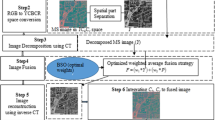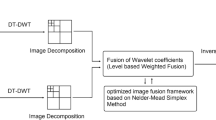Abstract
Image fusion plays a vital role in providing better visualization of image data. In this paper, we propose a new algorithm that optimally combines information from thermal images with a visual image of the same scene to create a single comprehensive fused image. In this work, an improved version of particle swarm optimization alogithm is proposed to optimally combine the thermal and visible images. The proposed algorithm is named self tunning particle swarm optimization (STPSO). Because of the importance of the fusion rule, a weighted averaging fusion rule is formulated that uses optimal weights resulting from STPSO for the fusion of both high frequency and low frequency coefficients obtained by applying Dual Tree Discrete Wavelet Transform (DT-DWT). The objective function in STPSO is formulated with the twin objectives of maximizing the Entropy and minimizing the Root Mean Square Error (RMSE), which differentiates our work from existing fusion techniques. The efficiency of our fusion algorithm is also evaluated by adding Gaussian white noise to the source images. The fusion results are compared with existing multi-resolution based fusion techniques, such as Laplacian Pyramid (LAP), Discrete Wavelet Transform (DWT) and Non Sub-Sampled Contourlet Transform (NSCT). The simulation results indicate that the proposed fusion framework results in better quality fused images when evaluated with subjective and objective metrics. Comparision of these results with those from PSO shows that our algorithm outperforms generic PSO.








Similar content being viewed by others
References
ALEjaily AM, El Rube IA, Mangoud MA (2008) Fusion of remote sensing images using contourlet transform. Innovations and advanced techniques in systems, computing sciences and software engineering 213–218.
AnoopSuraj A, Francis M, Kavya TS, Nirmal TM (2014) Discrete wavelet transform based image fusion and de-noising in FPGA. J Electr Syst Inf Technol 1:72–81
Arivazhagan S, Ganesan L, Subash Kumar TG (2009) A modified statistical approach for image fusion using wavelet transform. SIViP 3(4):137–144
Bebis G, Gyaourova A, Singh S, Pavlidis I (2006) Face recognition by fusing thermal infrared and visible imagery. Image Vision Comput J 24:727–742
Bhateja V, Patel H, Krishn A, Sahu A (2015) Multimodal medical image sensor fusion framework using cascade of wavelet and contourlet transform domains. IEEE Sensors J 15(12):6783–6790
Bhuvaneswari C, Aruna P (2014) A new fusion model for classification of the lung diseases using genetic algorithm. Egypt Inform J 15:69–77
Bulanona DM, Burksa TF, Alchanatis V (2009) Image fusion of visible and thermal images for fruit detection. Biosyst Eng 103:12–22
Chen H-Y, Leou J-J (2012) Multispectral and multi-resolution image fusion using particle swarm optimization. Multimed Tools Appl 60(3):495–518
Daneshvar S, Ghassemian H (2010) MRI and PET image fusion by combining IHS and retina-inspired models. Inf Fusion 11:114–123
Dey T (2013) A survey on different fusion techniques of visual and thermal images for human face recognition. Int J Electron Commun Comput Eng Vol-4
Duan H, Luo Q, Ma G (2013) Hybrid particle swarm optimization and genetic algorithm for multi-UAV formation reconfiguration. IEEE Comput Intell Mag 8:16–27
Ellmauthaler A, Pagliari CL, da Silva EAB (2013) Multi-scale image fusion using the undecimated wavelet transform with spectral factorization and Non-orthogonal filter banks. IEEE Trans Image Process 22(3):1005–1017
El-Maadi A, Gregoire V, St-Laurent L, Torresan H, Turgeon B, Prevost D, Hebert P, Laurendeau D, Ricard B, Maldague X (2007) Visible and infrared imagery for surveillance applications: software and hardware considerations. QIRT J 4:25–40
Farokhi S, Shamsuddin SM, Sheikh UU, Flusser J, Khansari M, Jafari-Khouzani K (2014) Near infrared face recognition by combining Zernike moments and undecimated discrete wavelet transform. Digital Signal Process 31(2014):13–27
Hongbin P, Sun D-W (2014) Using wavelet textural features of visible and near infrared hyper-spectral image to differentiate between fresh and frozen–thawed pork. Food Bioprocess Technol 7(11):3088–3099
Jedrasiak K, Nawrat A, Daniec K, Koteras R, Mikulski M, Grzejszczak T (2012) A prototype device for concealed weapon detection using IR and CMOS cameras fast image fusion computer vision and graphics. Volume 7594 of the series Lecture Notes in Computer Science pp 423–432
Ji X, Zhang G (2015) Image fusion method of SAR and infrared image based on Curvelet transform with adaptive weighting. Multimed Tools Appl 1–17
Jian M, Dong J (2010) Capture and fusion of 3d surface texture. Multimed Tools Appl 53:237–251
Jin H, Wang Y (2014) A fusion method for visible and infrared images based on contrast pyramid with teaching learning based optimization. Infrared Phys Technol 64:134–142
Keller W (2004) Wavelets in geodesy and geodynamics. DeGruyter, Berlin
Kingsbury N (2003) Design of Q-shift complex wavelets for image processing using frequency domain energy minimization. In: International Conference on Image Processing. 1013–1016
Kludas, J (2010) Information fusion for multimedia: exploiting feature interactions for semantic feature selection and construction. Thesis
Kludas J, Bruno E, Marchand-Maillet S (2008) Can feature information interaction help for information fusion in multimedia problems? Multimed Tools Appl 42:57–71
Kong WW, Lei YJ, Lei Y, Zhang J (2010) Technique for image fusion based on non-subsampled contourlet transform domain improved NMF. Sci China Inf Sci 53(12):2429–2440
Lacewell CW, Gebril M, Buaba R, Homaifar A (2010) Optimization of image fusion using genetic algorithms and discrete wavelet transform. Aerospace and Electronics Conference (NAECON), Proceedings of the IEEE 2010 National. 116–121
Li X, He M, Roux M (2010) Multifocus image fusion based on redundant wavelet transform. IET Image Process 4(5):283–293
Li H, Manjunath BS, Mitra SK (1995) Multi-sensor image fusion using the wavelet transform. Graph Model Image Process 57:235–245
Liu Z, Blasch E, Xue Z, Zhao J, Laganiere R, Wu W (2012) Objective assessment of multi-resolution image fusion algorithms for context enhancement in night vision: A comparative study. IEEE Trans Pattern Anal Mach Intell 34(1)
Liu X, Mei W, Du H, Bei J (2015) A novel image fusion algorithm based on non sub-sampled shearlet transform and morphological component analysis. SIViP 1–8.
Liu L, Wang D, Yang S (2008) Compound particle swarm optimization in dynamic environments” Evo workshops. LNCS 4974:617–626
Liu X, Zhou Y, Wang J (2014) Image fusion based on shearlet transform and regional features. Int J Electron Commun 68:471–477
Luo B, Wang Y, Liu Y (2010) Sensor fusion based head pose trackingfor lightweight flight cockpit systems. Multimed Tools Appl 52:235–255
Mahbubur Rahman SM, Omair Ahmad M, Swamy MNS (2010) Contrast-based fusion of noisy images using discrete wavelet transform. IET Image Process 4(5):374–384
Malviya P, Saxena A (2014) An improved Image Fusion Technique based on Texture Feature Optimization using Wavelet Transform and Particle of Swarm Optimization (POS). Int J Comput Appl 101(6)
Mansoorizadeh M, Moghaddam Charkari N (2009) Multimodal information fusion application to human emotion recognition from face and speech. Multimed Tools Appl 49:277–297
Miaindarg VC, Mane AP (2013) Decimated and Un-decimated wavelet transforms based image enhancement. Int J Ind Electr, Electron, Control Robot 3(5):26–30
Miao D, Sun Z, Huang Y (2014) Fusion of Multibiometrics based on a new robust linear programming. 22nd International Conference on Pattern Recognition
Muhammad A, Bala I, Shukri Salman M, Eleyan A (2014) DWT Sub-bands fusion using ant colony optimization for edge detection. IEEE 22nd Signal Processing and Communications Applications Conference (SIU 2014). 1351–1354
Nickabadi A, Ebadzadeh MM, Safabakhsh R (2011) A novel particle swarm optimization algorithm with adaptive inertia weight. Appl Soft Comput 11:3658–3670
Ou F, Han Z, Liu C, Ou Z (2010) Face verification with feature fusion of Gabor based and curvelet based representations. Multimed Tools Appl 57:549–563
Palsson F, Sveinsson JR, OrnUlfarsson M, Benediktsson JA (2015) Model-based fusion of multi-and hyperspectral images using PCA and wavelets. IEEE Trans Geosci Remote Sens 53(5):2652–2663
Petrovic V (2007) Subjective tests for image fusion evaluation and objective metric validation. Inf Fusion 8(2):2018–216
Ratnaweera A, Halgamuge SK, Watson HC (2004) Self-organizing hierarchical particle swarm optimizer with time-varying acceleration coefficients. IEEE Trans Evol Comput 8(3):240–255
Saeedi J, Faez K (2012) Infrared and visible image fusion using fuzzy logic and population-based optimization. Appl Soft Comput 12:1041–1054
Shamsafar F, Seyedarabi H, Aghagolzadeh A (2013) Fusing the information in visible light and near-infrared images for iris recognition. Mach Vis Appl 25(4):881–899
Sharma PK, Bhavya VS, Navyashree KM, Sunil KS, Pavithra P (2012) Artificial Bee colony and its application for image fusion. IJ Inf Technol Comput Sci 11:42–49
Shreyamsha Kumar BK (2013) Multifocus and multispectral image fusion based on pixel significance using discrete cosine harmonic wavelet transform. SIViP 7(6):1125–1143
Singh R, Khare A, Singh R, Khare A (2014) Fusion of multimodal medical images using Daubechies complex wavelet transform – A multi-resolution approach. Inf Fusion 19:49–60
Tan H, Huang X, Tan H, He C (2013) Pixel-level image fusion algorithm based on maximum likelihood and laplacian pyramid transformation. J Comput Inf Syst 9(1):327–334
Tao J, Li S, Yang B (2010) Multimodal image fusion algorithm using dual-tree complex wavelet transform and particle swarm optimization. Adv Intell Comput Theor Appl 93:296–303
Teo T-A, Lau C-C (2012) Pyramid-based image empirical mode decomposition for the fusion of multispectral and panchromatic images. EURASIP J Adv Sig Process 2012:4
Toet A (1989) Image fusion by a ratio of low-pass pyramid. Pattern Recogn Lett 9:245–253
Tong Y, Zhao M, Wei Z, Liu L (2014) Compressive sensing image-fusion algorithm in wireless sensor networks based on blended basis functions. EURASIP J Wirel Commun Netw 2014:150
Uniyal N, Verma SK (2014) Image fusion using morphological pyramid consistency method. Int J Comput Appl 95(25):34–38
Wang H-H (2004) A new multiwavelet-based approach to image fusion. J Math Imaging Vision 21:177–192
Wang W, Chang F (2011) A multi-focus image fusion method based on laplacian pyramid. J Comput 6(12):2559–2566
Wang S, Gao Z, He S, He M, Ji Q (2015) Gender recognition from visible and thermal Infrared facial images. Multimed Tools Appl 75:1–24
Wang S, He S, Wu Y, He M, Ji Q (2014) Fusion of visible and thermal images for facial expression recognition. Front Comput Sci 8(2):232–242
Yang Y, Tong S, Huang S, Pan L (2015) Multi focus image fusion based on NSCT and focused area detection. IEEE Sensors J 15(5):2824–2838
Yin M, Liu W, Zhao X, Yin Y, Guo Y (2014) A novel image fusion algorithm based on non sub-sampled shearlet transform. Optik 125(2014):2274–2282
Zhao J, Cheung S-CS (2014) Human segmentation by geometrically fusing visible-light and thermal imageries. Multimed Tools Appl 73(1):61–89
Zhou D, Gao X, Liu G, Mei C, Dong J, Liu Y (2011) Randomization in particle swarm optimization for global search ability. Expert Syst Appl 38:15356–15364
Author information
Authors and Affiliations
Corresponding author
Rights and permissions
About this article
Cite this article
Kanmani, M., Narasimhan, V. An optimal weighted averaging fusion strategy for thermal and visible images using dual tree discrete wavelet transform and self tunning particle swarm optimization. Multimed Tools Appl 76, 20989–21010 (2017). https://doi.org/10.1007/s11042-016-4030-x
Received:
Revised:
Accepted:
Published:
Issue Date:
DOI: https://doi.org/10.1007/s11042-016-4030-x




